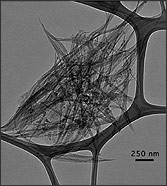The properties of the nanotubes depend on their structure, and scientists currently have only limited control over these structures, which are determined during the initial preparation, or growth, of the nanotubes.

Carbon nanotubes - long hollow cylinders composed of only carbon atoms - have many possible uses in nanotechnology, optics, electronics and many other fields. The properties of the nanotubes depend on their structure, and scientists currently have only limited control over these structures, which are determined during the initial preparation, or growth, of the nanotubes. In fact, admits one of the researchers, we don't know exactly how nanotubes grow.
In the article, published in the scientific journal Journal of Applied Physics, the researchers, led by Eray Aydil, professor of chemical engineering and materials science at the University of Minnesota, describe the effect of hydrogen gas on the preparation process.
"Carbon nanotubes grow from a particle of a metal catalyst found in gas, such as methane," explains the lead researcher. "Sometimes hydrogen gas is also added to the mixture, and it has been found that a small proportion of it helps the growth of carbon nanotubes with straight and sharp walls that contain a small amount of structural defects. However, too much of the hydrogen gas results in obtaining fibers with extremely thin walls, instead of nanotubes, or preventing the growth altogether."
To understand the exact mechanism responsible for these results, the researchers used a transmission electron microscope (TEM) and other methods to systematically simulate and characterize the effects of increasing hydrogen concentrations. "It turns out that the iron metal catalyst turns into iron carbide after a reaction with carbon that comes from the methane gas. "The iron carbide is a hard material that does not deform easily, and it turns out that the nanotubes grown from such a catalyst tend to have straight and sharp walls," explains the researcher. "Introducing an additional amount of hydrogen into the mixture turns the iron carbide into metallic iron - which is more flexible and malleable - and is responsible for obtaining fiber-like structures instead of the hollow carbon nanotubes," adds the researcher. At even higher concentrations of hydrogen, the gas "eats" the carbon nanotubes that are formed, and growth stops altogether.
